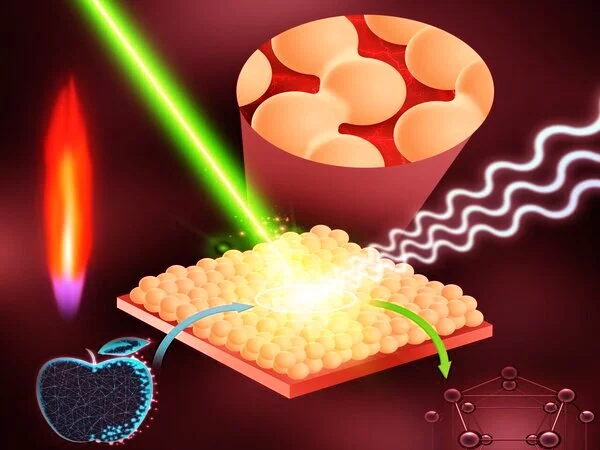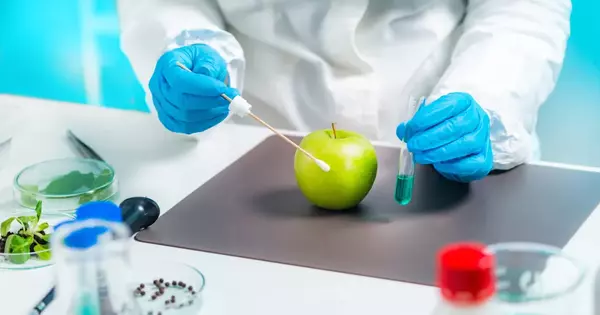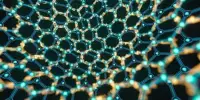Pesticides that contaminate food products such as fruit can have negative health consequences for consumers, but methods for detecting these chemicals are typically complex, time-consuming, and expensive. Surface-enhanced Raman scattering (SERS), which can increase the diagnostic signals of molecules on metal surfaces by more than a million times, faces the challenge of high production costs and limited batch-to-batch reproducibility, limiting their widespread application in food safety diagnostics. Karolinska Institutet researchers have now developed a faster, more reproducible, and less expensive fabrication method for SERS nanosensors that can detect pesticides in minutes.
Researchers at Sweden’s Karolinska Institutet have developed a tiny sensor that can detect pesticides on fruit in just a few minutes. The technique, described as a proof-of-concept in the journal Advanced Science, uses flame-sprayed silver nanoparticles to boost the signal of chemicals. While the research is still in its early stages, the researchers hope that these nano-sensors will aid in the detection of food pesticides prior to consumption.
“Reports show that up to half of all fruits sold in the EU contain pesticide residues that have been linked to human health problems in larger quantities,” says Georgios Sotiriou, principal researcher at Karolinska Institutet’s Department of Microbiology, Tumor and Cell Biology and the study’s corresponding author. “Current techniques for detecting pesticides on single products before consumption, however, are limited in practice due to the high cost and time-consuming manufacturing of its sensors. To address this, we created low-cost, reproducible nano-sensors that could be used to detect traces of fruit pesticides at a store, for example.”
Our sensors can detect pesticide residues on apple surfaces in five minutes without destroying the fruit. While they need to be validated in larger studies, we offer a proof-of-concept practical application for food safety testing at scale before consumption.
Haipeng Li
The new nano-sensors use surface-enhanced Raman scattering, or SERS, a powerful sensing technique that can increase the diagnostic signals of biomolecules on metal surfaces by more than a million times. The technology has been used in a variety of research fields, including chemical and environmental analysis, as well as the detection of biomarkers for a variety of diseases. However, high production costs and limited batch-to-batch reproducibility have prevented widespread use in food safety diagnostics.
Flame spray technology
In the current study, the researchers developed a SERS nano-sensor by delivering small droplets of silver nanoparticles onto a glass surface using flame spray, a well-established and cost-effective technique for depositing metallic coating.
“The flame spray can be used to quickly produce uniform SERS films across large areas, removing one of the major barriers to scalability,” says Haipeng Li, the study’s first author and a postdoctoral researcher in Sotiriou’s lab.

The distance between the individual silver nanoparticles was then fine-tuned by the researchers to improve their sensitivity. They used a spectrometer to uncover their molecular fingerprints after applying a thin layer of tracer dye on top of the sensors to test their substance-detecting ability. According to the researchers, the sensors reliably and uniformly detected molecular signals, and their performance remained unchanged when tested again after 2.5 months, demonstrating their shelf life potential and feasibility for large-scale production.
Detected pesticides on apples
To test the sensors’ practical application, the researchers calibrated them to detect low concentrations of parathion-ethyl, a toxic agricultural insecticide that is banned or restricted in most countries. A small amount of parathion-ethyl was placed on part of an apple. The residues were later collected with a cotton swab that was immersed in a solution to dissolve the pesticide molecules. The solution was dropped on the sensor, which confirmed the presence of pesticides.
“Our sensors can detect pesticide residues on apple surfaces in five minutes without destroying the fruit,” says Haipeng Li. “While they need to be validated in larger studies, we offer a proof-of-concept practical application for food safety testing at scale before consumption.”
Next, the researchers want to see if the nano-sensors can be used in other areas, such as finding biomarkers for specific diseases at the point-of-care in resource-limited settings. The research was supported by the European Research Council (ERC), Karolinska Institutet, the Swedish Foundation for Strategic Research (SSF), and the Swedish Research Council.















